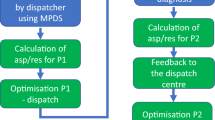Abstract
This paper treats the coordination of Emergency Medical Assistance (EMA) and hospitals for after-hours surgeries of urgent patients arriving by ambulance. A standard hospital approach during night-shifts is to have standby surgery teams come to hospital after alert to cover urgent cases that cannot be covered by the in-house surgery teams. This approach results in a considerable decrease in staffing costs in respect to having sufficient permanent in-house staff. Therefore, coordinating EMA and the hospitals in a region with their outhouse staff with the objective to have as fast urgent surgery treatments as possible with minimized cost is a crucial parameter of the medical system efficiency and as such deserves a thorough investigation. In practice, the process is manual and the process management is case-specific, with great load on human phone communication. In this paper, we propose a decision support system for the automated coordination of hospitals, surgery teams on standby from home, and ambulances to decrease the time to surgery of urgent patients. The efficiency of the proposed model is proven over simulation experiments.
Access this chapter
Tax calculation will be finalised at checkout
Purchases are for personal use only
Similar content being viewed by others
References
Bandara, D., Mayorga, M.E., McLay, L.A.: Optimal dispatching strategies for emergency vehicles to increase patient survivability. Int. J. Oper. Res. 15(2), 195–214 (2012)
Bertsekas, D.P.: The auction algorithm: a distributed relaxation method for the assignment problem. Ann. Oper. Res. 14(1), 105–123 (1988)
Cardoen, B., Demeulemeester, E., Beliën, J.: Operating room planning and scheduling: a literature review. Eur. J. Oper. Res. 201(3), 921–932 (2010)
Elton, D., Giacomo, C., Letizia, L.: Coordination issues in an agent-based approach for territorial emergence management. In: 2011 IEEE Workshops of International Conference on Advanced Information Networking and Applications (WAINA), pp. 184–189. IEEE (2011)
Dexter, F.: Influence of staffing and scheduling on operating room productivity. In: Kaye, A.D., Fox, C.J., Urman, R.D. (eds.) Operating Room Leadership and Management, pp. 46–66. Cambridge University Press, New York (2012)
Guerriero, F., Guido, R.: Operational research in the management of the operating theatre: a survey. Health Care Manag. Sci. 14(1), 89–114 (2011)
Haghani, A., Hu, H., Tian, V.: An optimization model for real-time emergency vehicle dispatching and routing. In: 82nd Annual Meeting of the Transportation Research Board, Washington (2003)
Henderson, S.G.: Operations research tools for addressing current challenges in emergency medical services. In: Wiley Encyclopedia of Operations Research and Management Science (2011)
Henderson, S.G., Mason, A.J.: Ambulance service planning: simulation and data visualisation. In: Brandeau, M.L., Sainfort, F., Pierskalla, W.P. (eds.) Operations Research and Health Care: A Handbook of Methods and Applications, vol. 70, pp. 77–102. Springer, Boston (2004)
Ingolfsson, A.: Ems planning and management. In: Zaric, G.S. (ed.) Operations Research and Health Care Policy, pp. 105–128. Springer, New York (2013)
López, B., Innocenti, B., Busquets, D.: A multiagent system for coordinating ambulances for emergency medical services. IEEE Intell. Syst. 23(5), 50–57 (2008)
Lujak, M., Billhardt, H.: Coordinating emergency medical assistance. In: Ossowski, S. (ed.) Agreement Technologies, pp. 597–609. Springer, Dordrecht (2013)
Maxwell, M.S., Restrepo, M., Henderson, S.G., Topaloglu, H.: Approximate dynamic programming for ambulance redeployment. INFORMS J. Comput. 22(2), 266–281 (2010)
Mielczarek, B., Uziałko-Mydlikowska, J.: Application of computer simulation modeling in the health care sector: a survey. Simulation 88(2), 197–216 (2012)
Patrick, J.M., Puterman, L., Queyranne, M.: Dynamic multipriority patient scheduling for a diagnostic resource. Oper. Res. 56(6), 1507–1525 (2008)
Postma, S., Jan-Henk, E., Dambrink, M.-J., de Boer, A.T., Gosselink, G.J., Eggink, H., van de Wetering, F., Hollak, J.P., Ottervanger, J.C.A., Hoorntje, E.K., et al.: Prehospital triage in the ambulance reduces infarct size and improves clinical outcome. Am. Heart J. 161(2), 276–282 (2011)
Rais, A., Viana, A.: Operations research in healthcare: a survey. Int. Trans. Oper. Res. 18(1), 1–31 (2011)
Song, L., Yan, H., Hu, D.: Patients with acute myocardial infarction using ambulance or private transport to reach definitive care: which mode is quicker? Intern. Med. J. 40(2), 112–116 (2010)
van Oostrum, J.M., Van Houdenhoven, M., MJ Vrielink, M., Klein, J., Hans, E.W., Klimek, M., Wullink, G., Steyerberg, E.W., Kazemier, G.: A simulation model for determining the optimal size of emergency teams on call in the operating room at night. Anaesth. Analg. 107(5), 1655–1662 (2008)
Acknowledgements
This work was supported in part by the Spanish Ministry of Science and Innovation through the projects “AT” (Grant CONSOLIDER CSD2007-0022, INGENIO 2010) and “OVAMAH” (Grant TIN2009-13839-C03-02) co-funded by Plan E, and by the Spanish Ministry of Economy and Competitiveness through the project iHAS (grant TIN2012-36586-C03-02).
Author information
Authors and Affiliations
Corresponding author
Editor information
Editors and Affiliations
Rights and permissions
Copyright information
© 2015 Springer International Publishing Switzerland
About this paper
Cite this paper
Lujak, M., Billhardt, H., Ossowski, S. (2015). Optimizing Emergency Medical Assistance Coordination in After-Hours Urgent Surgery Patients. In: Bulling, N. (eds) Multi-Agent Systems. EUMAS 2014. Lecture Notes in Computer Science(), vol 8953. Springer, Cham. https://doi.org/10.1007/978-3-319-17130-2_21
Download citation
DOI: https://doi.org/10.1007/978-3-319-17130-2_21
Published:
Publisher Name: Springer, Cham
Print ISBN: 978-3-319-17129-6
Online ISBN: 978-3-319-17130-2
eBook Packages: Computer ScienceComputer Science (R0)




